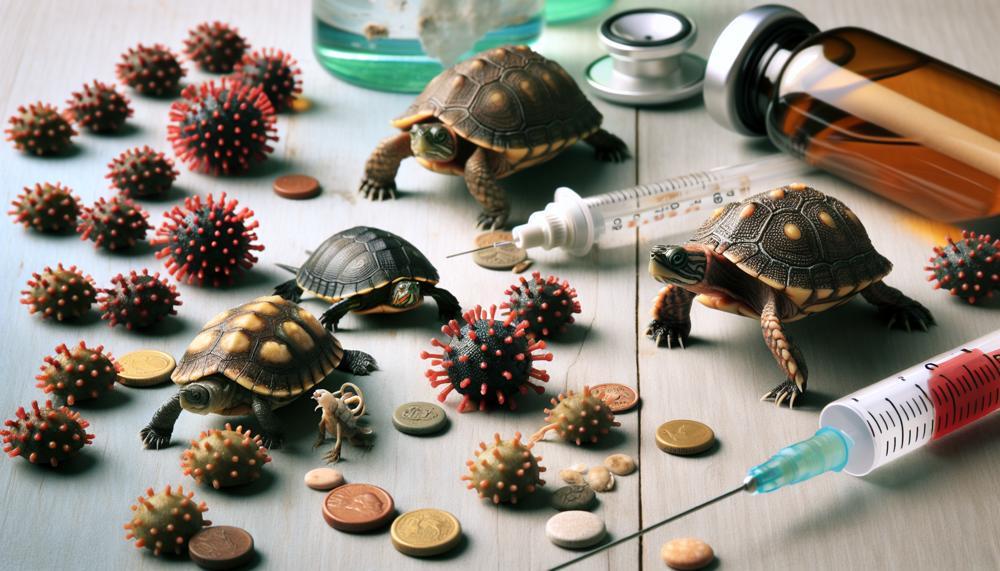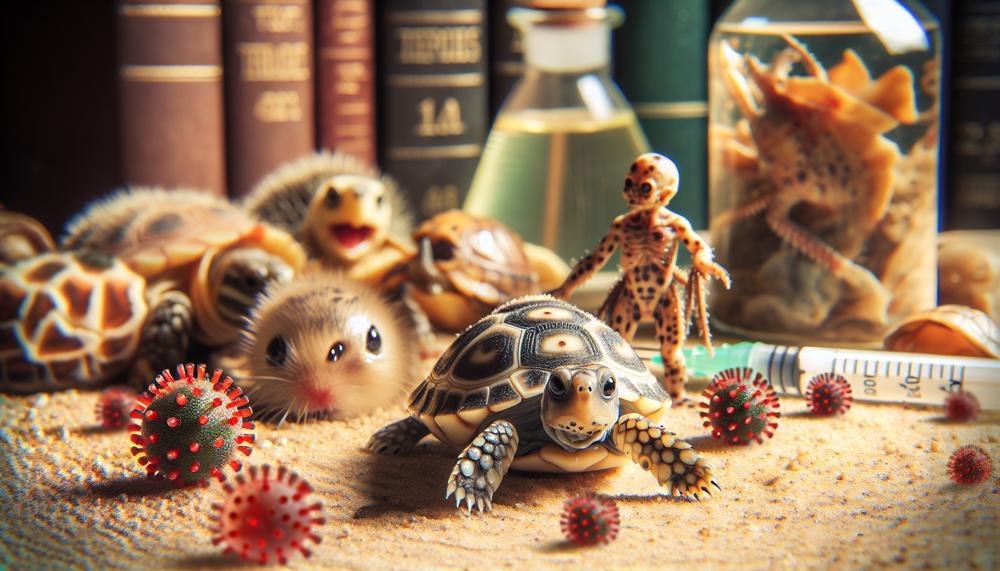As you wander through the serene landscapes of nature, you may come across a slow-moving creature that catches your eye – a turtle. With their cute and fascinating appearance, it’s hard not to be drawn to them.
However, many people don’t realize that these seemingly harmless creatures can carry dangerous diseases.
Yes, you heard it right. Turtles are not only adorable but also potential carriers of illnesses that can harm humans. In fact, the Centers for Disease Control and Prevention (CDC) has reported over 70 outbreaks of salmonella infection in the United States because of turtles.

So before you pick up that charming little reptile on your next adventure, here’s what you need to know:
- Salmonella bacteria is commonly found in turtles and can cause severe illness in humans.
- Children under 5 years old, pregnant women, and individuals with weakened immune systems are at a higher risk of getting sick from handling turtles.
- Direct contact with turtles or their habitats can transmit salmonella.
- Symptoms of salmonellosis include diarrhea, fever, and abdominal cramps.
- Proper handwashing after handling turtles or anything in their environment is crucial.
Now, let’s delve deeper into the world of turtle-borne diseases and how you can steer clear of them.
With these reptilian pets, it’s a classic case of looking but not touching.
Contents
Turtle Diseases
Turtles, while resilient, are prone to a range of health issues like shell rot, respiratory infections, parasitic problems, and even shell fractures.
To keep these ailments at bay, maintain a pristine and low-stress habitat. Offer balanced nutrition and seek timely veterinary intervention. Hygiene is crucial for preventing disease transmission from turtles to humans. Keep their living spaces spotless, and always practice good hand hygiene.
Shell rot, often caused by bacteria or fungi infiltrating small cracks in their shells, can become a serious infection. It may need antibiotics or antifungal treatments.
Respiratory infections, more prevalent in poorly maintained habitats, can be averted by ensuring cleanliness and adequate ventilation.
Parasitic infections, spurred by unclean water or food, call for meticulous habitat upkeep and a well-rounded diet.
Accidents or subpar living conditions can lead to shell fractures. This requires immediate veterinary care to prevent complications.
Salmonella
Salmonella is a type of bacteria that can cause illness in both humans and animals. It can also affect turtles. These reptiles can carry the bacteria on their skin and shell. They could be potential carriers of Salmonella.
However, detecting Salmonella in turtles is challenging as they may not show any symptoms.
But when symptoms do occur, they can include diarrhea, loss of appetite, lethargy, and swollen eyes. In severe cases, turtles may even experience septicemia, a life-threatening infection in the blood.
| How does salmonella affect turtles? | What are the symptoms? |
| Salmonella can cause illness in turtles. | Infection in the blood (septicemia) |
| The bacteria can be found on the turtle’s skin and shell. | Diarrhea |
| Salmonella can be transmitted through contact with turtle droppings or contaminated surfaces. | Loss of appetite |
| Turtles may not show any symptoms of Salmonella infection. | Lethargy |
| Swollen eyes |
To prevent Salmonella transmission from turtles to humans, proper hygiene is crucial.
Always wash your hands after handling turtles or cleaning their habitats. It is also recommended to have a separate tank for your turtle to live in and to avoid letting them roam freely around your home.
Regularly clean and disinfect your turtle’s tank and accessories. This can help reduce the risk of Salmonella transmission.
Zoonotic Diseases
Turtles can carry and transmit several zoonotic diseases to humans. These include salmonellosis, campylobacteriosis, leptospirosis, lymphocytic choriomeningitis (LCMV), and mycobacteriosis. These diseases can be spread through contact with contaminated turtle feces or water. They can also be spread through direct contact with the animal itself. To avoid contracting these illnesses, it is crucial to practice good hygiene and handling techniques. This is important when interacting with turtles.
The first and most well-known of these diseases is salmonellosis. This bacterial infection can cause symptoms such as diarrhea, fever, and abdominal cramps. It is most commonly transmitted through consuming contaminated food or water, but can also be spread through contact with infected animals.
Another common zoonotic disease carried by turtles is campylobacteriosis. Similar to salmonellosis, this bacterial infection can cause diarrhea, fever, and abdominal pain. It is usually contracted through consuming contaminated food or water. It can also be spread through direct contact with infected animals.
Other Diseases That Turtles May Carry
Leptospirosis is a bacterial infection that affects both humans and animals. It can cause symptoms such as high fever, headache, muscle aches, and vomiting. This disease is most commonly transmitted through water contaminated with the urine of infected animals.
Lymphocytic choriomeningitis (LCMV) is a viral disease that can be transmitted through contact with infected rodents or their droppings. Turtles themselves may not carry this disease. However, they can come into contact with infected rodents in their environment.
Finally, mycobacteriosis is a bacterial infection that can cause symptoms such as weight loss, lethargy, and respiratory problems. It is commonly spread through exposure to contaminated water sources.
Hygiene and Tank Maintenance
Proper hygiene and tank cleanliness are crucial for preventing turtle diseases.
By keeping their living environment clean and free of harmful bacteria, you can decrease the likelihood of your turtle contracting and spreading zoonotic diseases.
Here are some ways that maintaining hygiene and tank cleanliness can help prevent diseases in turtles:
- Regularly removing waste: Turtles are known to be messy pets and produce a significant amount of waste, which can quickly accumulate and lead to dangerous levels of ammonia in their tank. By regularly cleaning the tank and removing waste, you can prevent the buildup of harmful bacteria.
- Using a reliable filter: A good canister filter is essential for turtle tanks as it can effectively remove waste and maintain clear water. Adding filter floss to the filtration system can further improve water quality.
- Vacuuming the substrate: Waste and food particles can also sink to the bottom of the tank, contributing to ammonia levels. Regularly vacuuming the substrate with a gravel vacuum will help keep the water clean and prevent bacterial growth.
- Utilizing a UV sterilizer: These devices emit UV light to kill harmful microorganisms in the water, preventing cloudy or smelly water and reducing the risk of disease transmission.
- Performing regular water changes: Turtles produce a significant amount of waste, so performing regular partial water changes is necessary to keep nitrate levels in check. It is important to dechlorinate the water before adding it back into the tank.
- Incorporating plants or shrimp: Aquatic plants and shrimp can help maintain clean water by absorbing excess nutrients and aiding in controlling algae growth.
- Practicing proper feeding habits: Overfeeding turtles can lead to excess waste in the tank, so it is crucial to follow a regular feeding schedule and only feed as much as your turtle can consume in one sitting.
When you implement these tips for proper hygiene and tank maintenance, you can create a clean and healthy environment for your turtles. This reduces their risk of contracting and spreading diseases.
It is also essential to regularly monitor your turtle’s health and seek veterinary care if you notice any concerning symptoms.
Conclusion
In conclusion, while turtles may seem like gentle and lovable creatures, they can actually harbor dangerous diseases that can pose a threat to humans.
The most prevalent of these is salmonella, a bacteria that can cause severe illness in individuals of all ages. However, turtles can also carry other illnesses, such as shell rot, respiratory infections, parasitic infections, and shell fractures.
To safeguard yourself from these potential health hazards, it is crucial to practice good hygiene when handling turtles. And maintain a clean living environment for them. Regular visits to the veterinarian can also aid in preventing and treating any potential health issues in your pet turtle.
Remember, prevention is always better than cure. Protect yourself and your beloved pet turtle from harmful diseases.






